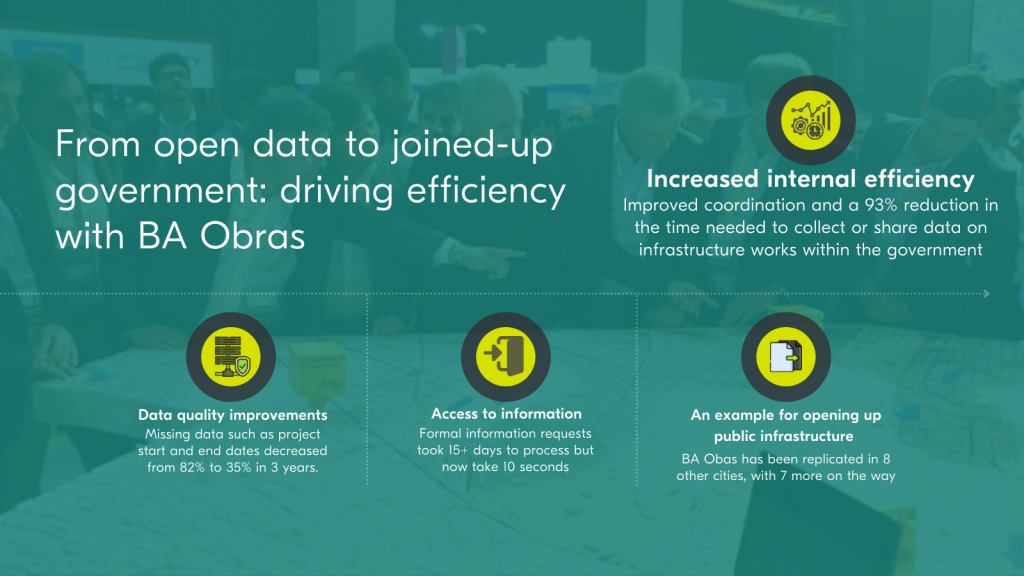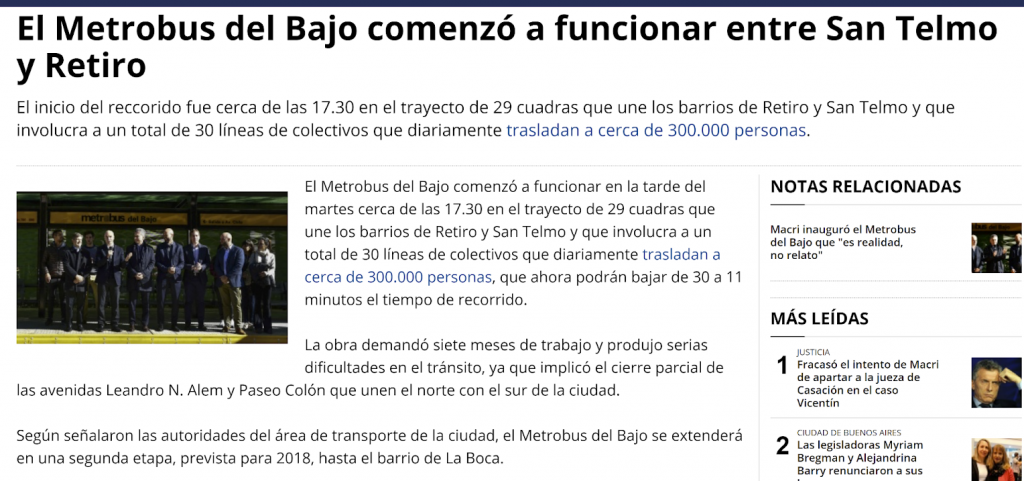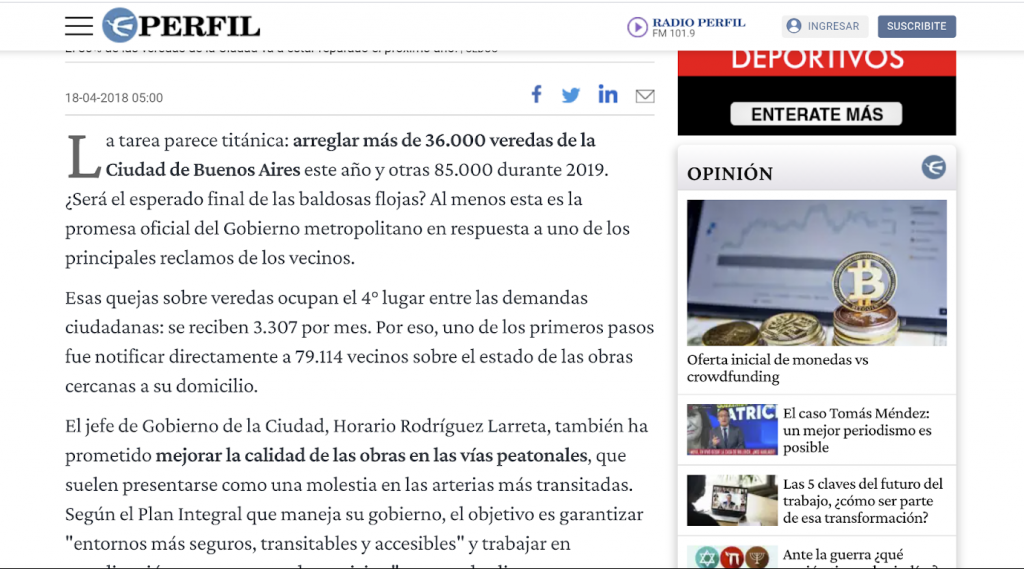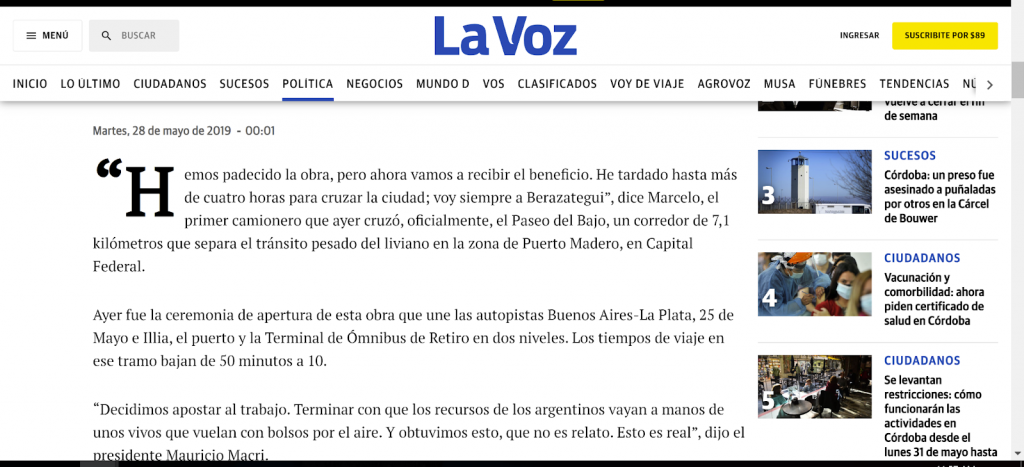From open data to joined-up government: driving efficiency with BA Obras

At OCP, part of our job is to capture and share inspiring examples of what works to open up and transform public contracting.
Public works are one of the most difficult and challenging tasks facing the government – plagued by bureaucracy, mismatched expectations and often running late and over budget. To avoid the ambitious US$3.5 billion public works program in Buenos Aires getting tied up in red tape, the city government took an open and radical approach, prioritizing collaboration across their departments as well as with citizens and communities. They created BA Obras, an interactive platform, powered by open data, that allows anyone to see detailed information on over 1,100 infrastructure projects within seconds.
The initiative has triggered profound changes, improving internal efficiency and coordination between government departments. Data that once took weeks to collect and share from multiple, siloed systems can now be accessed from one place in near real-time. This joined-up approach not only helps civil servants to do their jobs better, but makes life easier for journalists and civil society organizations who can now keep abreast of public works in their neighborhood and suppliers looking for new business opportunities. Citizen complaints have decreased. And it has set a precedent for opening up public infrastructure: BA Obras has since been replicated in 8 other cities in the Americas.

In early 2017, the city government of Buenos Aires launched an ambitious infrastructure investment plan worth more than 31.8 billion Argentine pesos (US$3.5 billion). By the end of 2019, the government had built more than 1,000 new homes, 30 schools, a modern transport corridor, 25 underpasses, and eight new bus lanes. They had extended cycle lanes by 250 kilometers and added 110 hectares of green space. As part of a massive regeneration program, more than a dozen informal settlements with over 300,000 residents were upgraded with new housing, land rights, improved services, schools, medical centers, roads, parks and offices.
As projects increased, so did public complaints. Citizens were annoyed about the congestion and other disruptions. The government wanted to better explain what was happening: what was being done, why, when and how they would improve local neighborhoods and city life.
Complaints about projects in the media:



Within the Ministry of Urban Development, a handful of officials started to systematize data on public works projects carried out by the Ministry so that data would be easily accessible to the public on an open platform. They went round to all the offices in the ministry to drum up support.
Through a series of strategic meetings, key officials began to understand the importance of opening up information, not only for improving understanding of the government’s infrastructure investments, but for managing them better too. By centralizing and standardizing all infrastructure data, the government could create a single system for coordinating investments, managing risks and better monitoring the progress of these large and complex projects. Such an approach would need to take into account many different players in the project life cycle, who don’t always work well together — project owners, designers, risk managers, quality-control and safety experts — and help these parties set clear organizational structures, responsibilities and common priorities.
For Álvaro Herrero, then Undersecretary of Strategic Management and Institutional Quality, this was an opportunity to align “open government initiatives and ideas with the government’s political priorities.” The project, which started off as a process of systematizing infrastructure works data in the offices of the Ministry of Urban Development, was expanded to all government departments.
From the outset, there were a number of major challenges, says Martin Ibarra, another architect of the reform. “Some [departments] already had standardized [data], some had information on paper, while others had data in an Excel spreadsheet,” Ibarra recalls. Herrero explains that they had to combat “the lack of coherent data policies. Not just a lack of open data policies but a lack of any kind of data policy. Because each ministry does its own thing, [and] has its own processes.”
Ibarra explains that the first step was to understand what data each of the government departments had in order to identify common patterns so that a single, standardized template could be created for uploading information onto the site and, more importantly, to monitor public works processes. This collaborative effort was a mammoth task, transforming the way public officials operated and cooperated across departments and it was crucial to the creation of BA Obras [Obras means ‘works’ in Spanish]. Today, BA Obras gathers data from all infrastructure projects undertaken in the City of Buenos Aires from 2016 onwards. Users can search more than 1,100 works to learn who the contracts were awarded to, the percentage of completed works, duration and costs, among other details.
Empowering vulnerable communities to hold government to account
BA Obras has become invaluable for monitoring public works in the most vulnerable districts of Buenos Aires. This is extremely important given that over 300,000 people live in these areas (10% of the city’s population). In fact, according to figures provided by officials, most searches made on the platform concern projects being carried out in Villa 31, an urban center with over 40,000 inhabitants and one of the most deprived neighborhoods in the city.
For more than eight years, the Civil Society Association for Equality and Justice (ACIJ) has been monitoring and highlighting “the serious deficits in the provision of public services and urban infrastructure” in these vulnerable areas through its “Caminos de la Villa” initiative. BA Obras makes this important work so much easier as it maps all public works in villas 31, 20, Rodrigo Bueno and Playón Chacarita and provides those living there with important information on urban integration processes so that they can keep track of what the government is doing in their neighborhood.
Laura Lacayo and Rosario Fassina from ACIJ explain: “A lot of the information that we used to get through public information access requests is now sourced through BA Obras. That means that much of the paperwork and processes we had to follow to get that information are now no longer required,” saving civil society organizations and poorer communities time and money. The site’s dataset has also helped them to analyze the neighborhoods with the highest and lowest concentration of public works, the types of works prioritized, the status of the works and the companies that have won the highest number of tenders. However, some challenges remain with regard to the quality of information. Fassina explains that they are often unable to draw definitive conclusions from the data because certain fields are missing information: “The information is accessible on the website but data extraction and indicators could be improved to develop stories with more depth…”
Data collection and analysis improves
Through the BA Obras platform and other community engagement activities, the reform achieved its original aim of helping the public better understand infrastructure projects in their area. The process has inspired an even more profound cultural shift within the government: because they can see the impact, civil servants are now motivated to share data with other departments.
Departments have lost their fear of sharing because they understand that doing so is expected as part of their jobs.
“Departments have lost their fear of sharing because they understand that doing so is expected as part of their jobs,” says Lorena Schejtman, a former communications officer at the Ministry of Urban Development. “They are proud of their work.”
This kind of cross-sector departmental data sharing is one of the most important factors influencing the success or failure of infrastructure projects. The new model means that a unified system now exists that enables all the different government departments with different responsibilities to upload information quickly, regularly and easily. Departments now proactively report data on infrastructure works on a monthly basis, without having to be asked for that information. Simply by logging onto the system, each department can now see up-to-date information on all public works including projects or processes not directly under their purview. As a result, the procedures for searching and accessing information between departments have become less bureaucratic and more efficient. Ibarra estimates that data collection processes that once took up to two whole weeks to complete on every project, can now be done in just one day, representing a time saving of 93% for tasks of this kind. This more orderly and organized way of sharing large volumes of data and coordinating tasks can save a government administration significant time, which they can spend on other essential tasks and activities.
Improving access to information has also enabled departments not responsible for public works to use data for their own analysis and to achieve broader goals. For example, the Urban Anthropology Department – which ensures the needs of communities are reflected in government projects – used BA Obras data to inform the design and implementation of participation mechanisms in local neighborhoods to improve social welfare: “From the platform we could access information on each work’s start date, the execution time, when it was going to be finished and that gave us key information to improve our project design to better meet people’s needs (…) we did not have to request data from each office. It was available on the platform for any citizen but it also helped us as a government agency to carry out our work,” explains Javier Irigaray, who led the Urban Anthropology Department when BA Obras was introduced and is now the city’s General Director of Institutional Quality and Open Government.
From the platform we could access information on each work’s start date, the execution time, when it was going to be finished and that gave us key information to improve our project design to better meet people’s needs (…) we did not have to request data from each office. It was available on the platform for any citizen but it also helped us as a government agency to carry out our work.
BA Obras has broken down silos in government and connected them to other government systems. This initiative is now linked to a much larger project, the Plataforma Integral de Gestión (PIG) which was created by the Office of the Chief of Cabinet Ministers to monitor the performance of government agencies. The Cabinet can scrutinize government actions in almost real time. In 2019 alone, the Plataforma Integral de Gestión allowed key public servants, including the governor, to check the status of more than 1,100 projects at the click of a button. Among the many benefits of integrating both systems, the government highlights that BA Obras has helped to foster more informed and meaningful interactions between the governors and citizens, especially during the governor’s ‘weekly walks’ to engage citizens in local neighborhoods. In short, BA Obras appears to have helped to improve efficiency by enabling better planning, tighter coordination and greater oversight and performance monitoring.
The city at your fingertips: empowering journalists and civil society organizations to build trust and integrity
The BA Obras team developed a strategy to reach as many people as possible to share vital information and incentivize use of the platform. Capitalizing on the governor’s weekly meetings with local residents, public officials brought iPads and digital displays to show what infrastructure projects were being built in the neighborhoods they were visiting. These ‘Show & Tell’ meetings were tailored to respond to the specific interests of city residents.
With just a few clicks, the city’s residents can easily find information such as total investment in their neighborhood, number of infrastructure works in their area, percentage of completed projects, construction company, budget, start and completion dates and tendering documents. The link to the full information on the project was also added to the project information billboards displayed at every construction site. Before BA Obras, this information could only be obtained by submitting formal requests under the Law on Access to Public Information or by attempting to reconstruct documents that were scattered across multiple different government sites.

Government officials report that their communication departments have seen a reduction in the number of email inquiries, as people can simply check the platform. According to official statistics, BA Obras received more than 526,000 unique visits between July 2017 and August 2020, peaking during election periods. The platform became a useful tool for the opposition to hold the government to account and ask questions on project progress and performance. A 2017 survey conducted by the government to measure public perceptions showed that of all the city government’s various initiatives, city locals valued the plans and actions on infrastructure including transport and public spaces the most.
Transparency has not only benefited citizens eager to find out what is happening on their block but has also been useful for journalists and civil society organizations. The platform’s dataset has facilitated more extensive oversight of the city’s infrastructure works. According to the data journalism team at the LA NACION newspaper, the time taken to research articles has fallen from 60 to 15 days; reporters no longer need to submit official requests which used to take significant time to prepare and required extensive follow-up. Consequently, the newspaper published more in-depth investigations, adding value to its reports and differentiating its content from other media publications with interactive visualizations based on BA Obras open data that made it easier for their users to understand what was going on. Both government and civil society organizations, including the Department of Access to Information, Secretary of Communications and Citizen Participation and Asociación Civil por la Igualdad y la Justicia (CSO) all told OCP that, anecdotally, the number of public complaints has significantly reduced (although they were not able to provide exact numbers).
Comparing different versions of the dataset between 2016 and 2019, shows improvements to data quality. Whereas in the first dataset published, information of when a tender took place was available in only 37% of cases, that information has now increased to 68% of all contracts. Similarly, information on project duration improved its coverage from 49% to 91%. There was also a reduction in missing values, for example, in 2016 the procurement method was missing in 82% of cases, but this proportion decreased to 70% in 2017, 62% in 2018 to 35% in 2019, showing data quality improved. It is evident that efforts to improve data availability and data quality are ongoing, and it is important to continue this push to achieve even greater gains.
The use and regular reuse of the datasets by civil society organizations and journalists have also incentivized the government to introduce new fields into the dataset and improve existing fields to better meet user needs. For example, following recommendations received from users, improvements have been made to include not only the company name of each supplier but also its unique tax identification number (CUIT). This makes it easier for users to identify successful bidders and enables interoperability with other available databases and datasets, such as sworn statements by public officials and procurement data.
More opportunities for smaller businesses
Companies are also using the data on BA Obras to better participate in public procurement. Some of the biggest barriers to entry that prevent small and medium-sized enterprises (SMEs) from participating in public infrastructure tenders are the short notice periods for upcoming opportunities and the multiple, siloed systems where these opportunities are shared. SMEs do not have the same resources or capacity as large companies with dedicated procurement teams. Sourcing and ordering raw materials and supplies like concrete boom pumps or insulating bricks cannot happen overnight, even with the most efficient and quick suppliers. Operators, drivers, and security regulations all require careful scheduling, which can pause the construction or undo previous work. As a result, SMEs are less able to bid for contracts and miss out on opportunities.
BA Obras helps by giving vendors a clear picture of past procurement and project pipelines, so that SMEs are more able to participate. For example, ACINDAR, a local construction materials company, told OCP that they could now more accurately estimate public sector cement needs and purchase the sand, gravel and other raw materials in advance, so they are able to participate in public works tenders whilst at the same time improving efficiency and minimizing waste.
The available data suggest 50-60% of new suppliers are winning contracts for the first time every year (2017-2019). This could indicate BA Obras is helping government agencies diversify their supplier base whilst helping businesses to participate in public tenders. However, more and better data, including unique company identifiers, data on joint ventures or bidders, would enable a more definitive assessment.
The transformational impact of BA Obras and what lies ahead
Buenos Aires’s 2021-23 public works plan is already in process. To ensure its continued success, the city government has to step up its efforts to publish and use joined-up open data to further enhance efficiency and collaboration, strengthen trust, and level the playing field for businesses. In particular, BA Obras should be linked to Buenos Aires Compras, the city’s transactional e-procurement system so that all stakeholders can get the most complete and up-to-date picture of infrastructure projects and contracts.
Standardized, structured open data will help enable this interoperability and conversations are already underway to identify how the internationally recognized standards for open data on contracts and projects, that is, the Open Contracting Data Standard (OCDS) and Open Contracting for Infrastructure Data Standard (OC4IDS), can help.
This should go hand-in-hand with improving data availability as well as data quality, for example by including data on bidders and enforcing compliance on crucial fields such as unique company tax identifiers.
In March, the new public works law came into force. The legislation includes explicit provisions that guarantee citizen participation and public works’ data disclosure that is “agile, accessible to all users and in accordance with open data standards.” This provides the scaffolding for further open contracting reforms implementing the law.
Additional functions are planned for the new version of BA Obras: improved visualization tools will be developed to enhance localization that will improve searchability of projects down to the micro neighborhood level.
“The neighborhood will become its main axis”, explains Javier Irigaray. It’s not only about showing the big infrastructure projects but also helping to visualize data from programs and services that demonstrate “the change in people’s quality of life,” for example through the provision of lighting fixtures, new bike paths, health centers and nature trails. The platform will also include data on gender, climate change, and infrastructure projects conducted through citizen participatory mechanisms.
The success has found followers and BA Obras is being replicated elsewhere. So far, 8 cities across the Americas have successfully adopted the site, among them, Olavarría, Bahía Blanca and Veracruz in Mexico, and 7 more are working on it. Developing those platforms was easier and less expensive because they relied on the existing code and guidance created by the BA Obras team – available as an open source Github resource.
BA Obras shows that opening public infrastructure data can have positive impacts: improving public sector efficiency, enabling inter-agency coordination and improving trust by making sense of government’s actions for citizens and increasing competition and market opportunities. The initiative has also triggered a sort of domino effect which is making other mechanisms that operate and exist outside of the public works projects more efficient in Buenos Aires, and beyond.